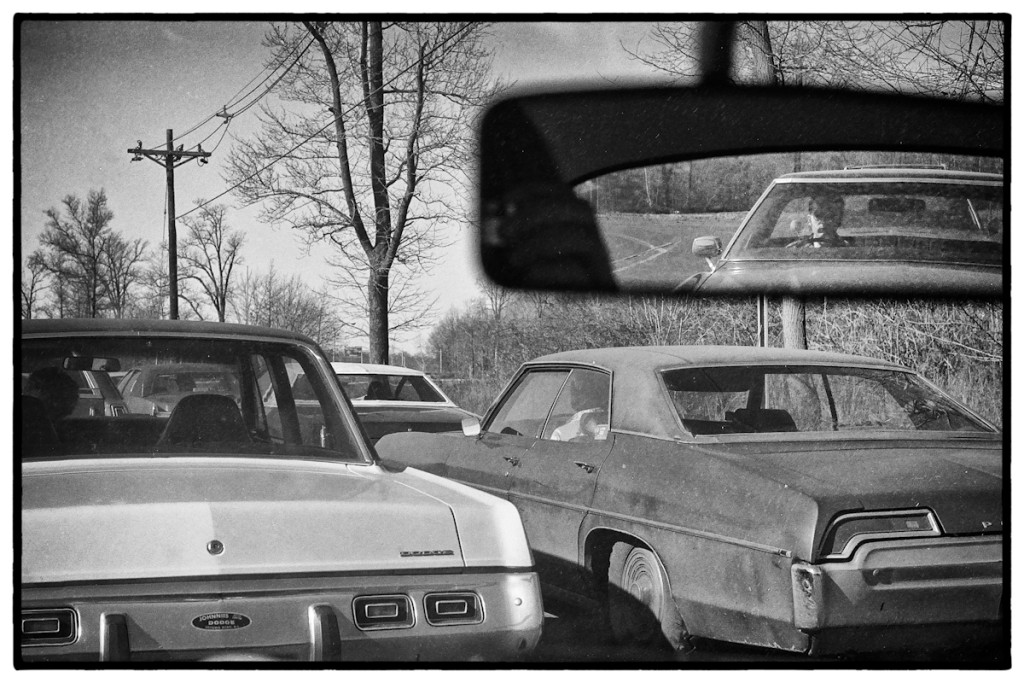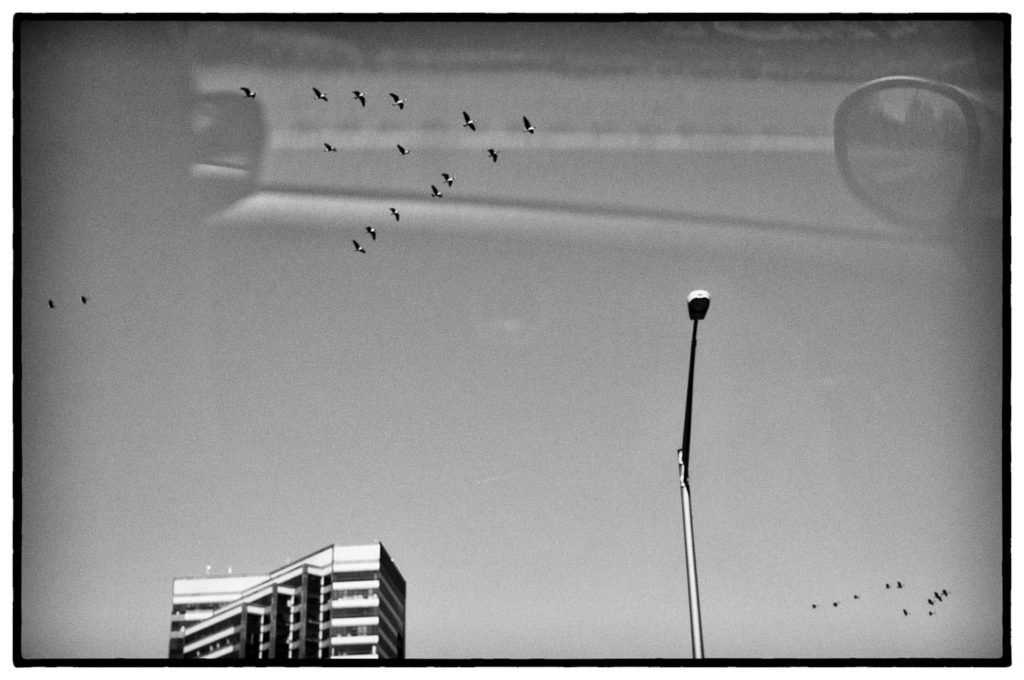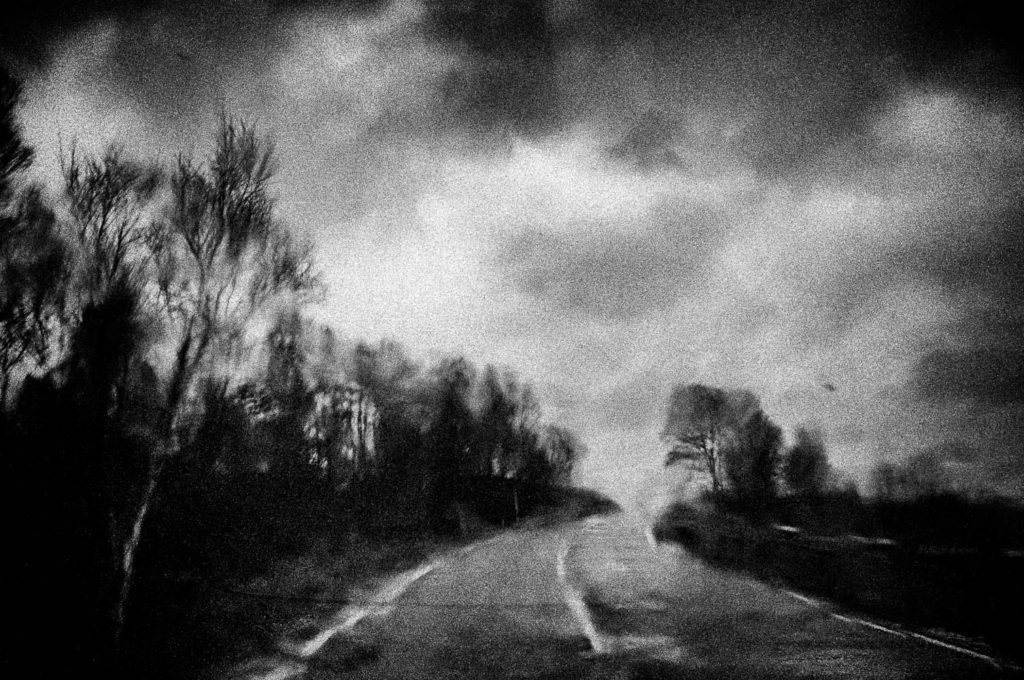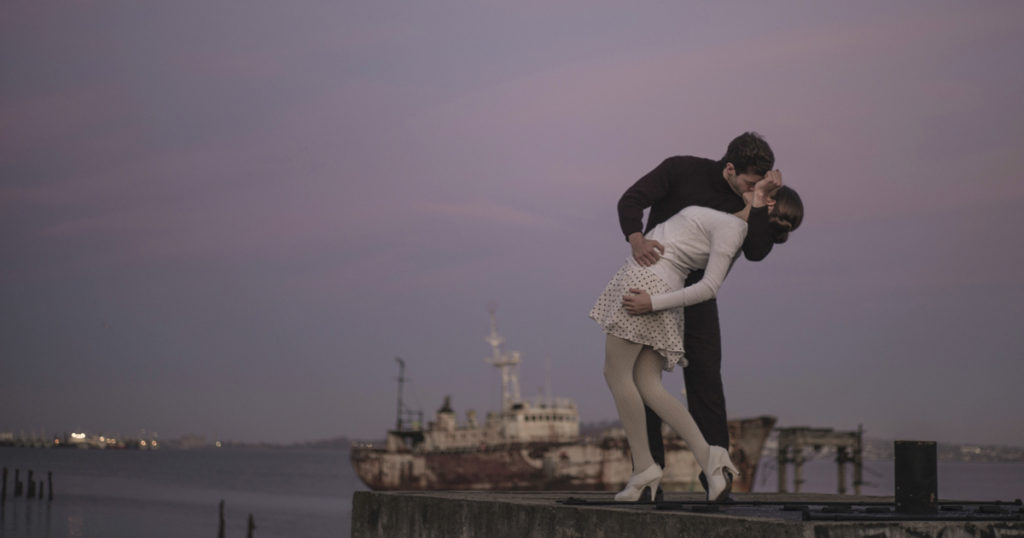In his book Mythologies, French Philosopher Roland Barthes writes about the difficulty one has, when travelling in a car, simultaneously seeing both the countryside and the car window. Our perceptual apparatus allows us to see both, but only one at a time. To see one is not to see the other. This might explain how Barthes died in excellent health at the relatively young age of 64 – run over by a laundry truck crossing the street in front of the Sorbonne while walking to one of his classes (true). Very appropriate end for a philosopher with his head in the clouds, but not the best. Heraclitus, the guy who said it wasn’t possible to step twice into the same river, died an even more philosophic death. When his doctors couldn’t cure him of chronic illness, Heraclitus decided to bury himself in dung, thinking this would do the trick. After covering himself in manure and sitting around for a while, he couldn’t free himself and died of starvation, trapped in a pile of shit. My wife predicts a similar end for me.
I’ve always been fascinated by photos through windows. You may have noticed. It’s also been an interest for others more notable – Frank, Koudelka, Kratochival, Winogrand, Friedlander, Moriyama et al. There’s something compelling about the constructed reality produced by the confluence of the reflector and the reflected. These photos help educate naive viewers that photographs don’t mirror or objectively recreate a ‘reality out there’ but rather are their own reality. And, to my mind, these photos refute Barthes’ claim that we can’t see both simultaneously – we can, via a photograph, at least as a fusion of the two that creates its own new reality.
*************
Roland Barthes was born in 1915 in Cherbourg, on the Atlantic coast of France, and raised by his mother in Paris after his father died in WW1. As a teen Barthes developed tuberculosus, resulting in an extended stay in a sanatorium, thanks to which he missed WW2. It also allowed him time to develop a wide range of intellectual interests. From this enforced self-education, Barthes became an early theorist of Semiology – the science of signs and meanings – whereby he attempted to explain human activity by analyzing how signs (signifiers”) construct reality.
Barthes’s first book, Writing Degree Zero (1953), considered the ways in which we employ language to think, yet are constrained within the confines of language itself, language whose meanings are arbitrary, not fixed. For example, brides wear white for weddings in America, but in China, Korea, and other Asian countries white represents death, mourning, and bad luck, and is traditionally worn at funerals. Is one culture ‘wrong’ about what white means? No. The meaning of white is not set in stone but is merely an agreed convention. This is true of all meanings in all cultures. To understand a culture, we need to first understand how meanings are produced, circulated, consumed and understood by those within it. Why? Because these meanings create that culture’s experience of the world.
Barthes was appointed to the prestigious École Pratique des Hautes Études in Paris in 1960. His next work (Elements of Semiology, 1965) looked at the primary elements of human existence – food, clothing, shelter – and how we talk about them. Semiology – the science of signs – breaks each act of communication into a signifier and the signified. The signifier is the word, gesture or object (a photograph, for example); the signified is what that word, gesture or photo means. To take an example, a red rose can signify different things, depending on context: If I give one to a woman on Valentine’s Day it means “I love you;” if I am confronted with an image of four of them at the liquor store it’s a reminder I’d be wise to buy a bottle of Four Roses bourbon; if I see one on a t-shirt in Lancashire UK it probably means the wearer is a fan of the Lancashire Rugby team. And then there’s what Barthes calls an something’s “degree zero” of meaning: that is, its status as just a thing – in our rose example, just a piece of flora. Practically speaking however, it’s impossible to see anything this way, because as humans we seem compelled to read meanings into objects. A rose is never just a rose.
Likewise, using the same semiotic analysis, a photograph is never merely a photograph, just an innocent copy of something out there. It’s much more loaded than that. Like every other object of perception, we attach certain meanings to it, meanings dependent on the cultural context. Semiotics rejects the naive understanding of the photo as a transparent window through which we see a slice of reality, a faithful copy of a “thing out there.” While Barthes doesn’t write of it, I’m sure he’d chuckle at the story told by Picasso, now old and venerated, who, visited in his Paris studio by a vulgar nouveau-riche, was asked why he had painted his portrait of Dora Maar in an abstract manner that clearly “didn’t look like her?” In reply, Picasso asked the man what his own wife looked like, and the man showed him a B&W photo of her he kept in his wallet, to which Picasso replied “so, she’s flat, without color and 2 inches square?”
Picasso’s point being that the “degree zero” of the painting or photo – its reality as a thing – is just a piece of canvas or paper with some markings on it, while what we read into it is what it represents, it’s “meaning.” Picasso was directing the man’s eyes from the signified to the sign itself, in so doing demonstrating that pictures don’t inherently “represent reality” or anything else but rather that we read the reality into them.
Anyway, back to Barthes.
Starting in the early 70’s, Barthes applied his semiotics eye to mass culture – clothing, fashion, painting, iconography, typography…and photography. What he was doing now was, like Picasso in the instance above, examining the signifier itself, the painting, clothing, typography or photograph – the communicating object – its feel and sensuality. His interest was how signs create meanings, but it was also his attempt to alert us to more nefarious implications; as citizens of modern, capitalist culture, the self-interested workings of that culture via its scripted words and images can’t but influence what we understand as real. In our hyper-capitalist culture, meanings constantly bombard us – via text but more and more via photographs that pretend to be neutral – with subtle but definable connotations; for Barthes, to get ourselves oriented in such a morass of meanings we must first consider the signifier itself as a filter (a “car-window”) that influences the way we see the “real” countryside beyond.
Of course, the implications of Barthes’ insights for us as photographers are fairly obvious. First, it opens up to us the fact that photographs aren’t just objective copies of something real ‘out there’ but are themselves constructed by the eye of the photographer, who is the curator of what gets seen by the viewer and the manner in which it gets seen, which then opens up the reality of photography as a creative medium – as Art – that so many would deny it. Second, it opens up the activity of the viewer as necessary to the photo’s meaning. Meaning, necessary in any coherent photograph, can be given both by the photographer but also by the viewer, and the two may not necessarily be the same. Third, it should alert us to the power of images and their role in forming – and distorting – what we perceive. The dark side of such a remarkable technology is that it can, in a capitalist consumer society (or in more malevolent social or political societies), be put to uses that might not serve our best interests, unless, of course, we can see through its seductive manipulations.
It’s this third implication that is the focus of Barthes’ analysis and what he’s warning us against. In doing so he’s reminding us that we, as recipients, can impose our own meanings on the texts and images we’re bombarded with. We have that power. Be critical of that photograph, Barthes is saying: It isn’t just a photo but rather an often devious means of making you see the world in a way that serve’s other’s purposes, a way that might not be your free choice and might distort your understanding. Only when you understand this will you be the master of your life’s meanings and not be mastered by a world of symbols deviously crafted to master you.







Lacking much formal study of philosophy, it’s taken me almost an entire lifetime to come to my own conclusion that the human mind and the physical world are mutually exclusive, save for the tenuous links provided by our five (or six) senses. When it comes to photography, a physical print or emulsion image is the only link between the two realms. Everything else is in our heads.
It’s no surprise that Picasso understood this completely, but almost every time I discuss this concept with others, I get funny looks…
Lee, you need a new set of friends. These are precisely the issues we ‘should’ be talking about. In any event, from your comments made here and elsewhere, it’s obvious to me that you’ve given them much thought. Your comments on the bodily experience of Leica use, which I incorporated into the article itself, are a good example. Thanks for your input.
I enjoy and look forward to reading what these French philosophers have to say, but as you suggest here, Monsieur Barthes’s primary point is that there is more than one way to skin a cat.
Pictures can and more usually are also meant to be read in a more superficial way. The iPhone picture of one’s dinner is most likely, from the snapper’s point of view and intent, a picture of a dinner that s/he is just about to tuck into. “Wish you were/weren’t here!”
Whilst I am a big fan of black and white film photography, works such as those in your text, might well be regarded by the above mentioned “iPhonographer”, as crap. As I once overheard my then teenage son say to one of his friends, “Dad is old enough to remember when the world was black and white”.
And as that Belgian chap noted: “Ceci n’est pas une pipe.”
Aren’t the Wetzlar scoundrels also rather superficially suggesting that if one buy’s into their latest and greatest jewel, that the buyer is going to be the next Alfred Eisenstaedt?
The question that pops into my little bonce is:
Are the daily outpourings of journalists that are paid to signal, through the various media, that Trump is a criminal, truthful? Or are they telling the silly consumers how important his opponents are, and how we need their tender loving attention at all times?
Were those 20th century French philosophers, like their 5th century Greek forebears, just trying to keep themselves in drink and conviviality?
So many questions…
Thank you for the content free political snippet. A Styrofoam drink cup thrown out of the car window in the lead-in image.
re Lead-in image: A freezing cold wet day riding through Kentucky in an old truck with shitty wipers. No cups thrown from vehicle. Not my style.
As for the political snippet, it can be read a number of ways, and certainly isn’t “content free.” It is, as a semiologist might say, “pregnant with meaning.” The simple fact that you’ve responded in the manner you have is evidence of its content and also proves the point that you as the reader imputed a certain meaning to it that may be at variance with what the author intended.
My post was directed at StephenJ’s post, hence the indent, if I correctly understand this site’s formatting. Am I to believe you believe I believe a physical cup was thrown out of a car window? Of course not. The image shows a windshield, and they haven’t been able to be opened in a very long time. Of course I could assume a car with a windshield would also have a window in at least one assumed door in some sort of Barthian signifier or whatever, but I have no reason to think the photographer would do that and the image, a good one too, gives no evidence either. Besides, it was metaphor and I think we both know that.
The political quip was certainly not content free, but certainly was not needed in the context of the rest of the post, detracted from it actually. If you’re not aware of such material seeping into a great many internet forums these days, whatever their coverage, you’re lucky. Dock me points for not knowing my Barthe.
Philosophy is hard at best and silly at worst; you can’t just talk about being, you have to be. That’s where most of the lessons are be learned anyway, whatever they might be.
Pictures can and more usually are also meant to be read in a more superficial way. The iPhone picture of one’s dinner is most likely, from the snapper’s point of view and intent, a picture of a dinner that s/he is just about to tuck into. “Wish you were/weren’t here!”
Not sure I agree. I think its these ostensible “throw-away” pictures people post to their social media accounts that are meant to carry the most meaning, that being one’s preferred definition of self. That avacado toast you’re enjoying at the cozy French bistro in, say, the Uptown neighborhood of Minneapolis, nestled next to a bottle and 2 glasses of Val Do Sosego Albarino Rias Baixas, is meant to signal more than simply what you’re eating.
Are the daily outpourings of journalists that are paid to signal, through the various media, that Trump is a criminal, truthful? Or are they telling the silly consumers how important his opponents are, and how we need their tender loving attention at all times?
Why can’t they be both? But I get your point, which is a good one.
That picture of the lamp, building, sky, birds, reflection is mesmerising. It’s perfection.
Thanks. Just a lucky shot. As are most good photos.
Yes, perhaps some new friends, although these days it’s hard to find anybody who isn’t consumed by one imaginary media fantasy or another. Meanwhile, the natural world patiently waits just outside, ready for our attention and appreciation.
“Heraclitus, the guy who said it wasn’t possible to step twice into the same river, died an even more philosophic death. When his doctors couldn’t cure him of chronic illness, Heraclitus decided to bury himself in dung, thinking this would do the trick. After covering himself in manure and sitting around for a while, he couldn’t free himself and died of starvation, trapped in a pile of shit. My wife predicts a similar end for me.
HAHAHAHAHAHAHAHAHA!!!
In her biographic video “Life through a lens”, shot by her sister, Annie Leibovitz relates that she spent much of her early life travelling by car from base to base, where her father was stationed during his time in the services. She said it was natural to see the world through a car’s window frame… artistic hindsight or just sound bite?
Rob